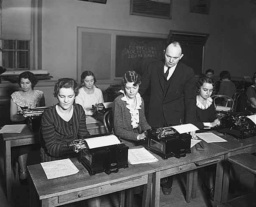

Typewriting Behavior Psyc... (1936)
by August Dvorak et al.


It will be difficult for older teachers, and younger ones who have been taught by them, to concede the possibility that the requirement of "accuracy" has been overdone, that "technique" (form, in the athlete's sense) is to be striven for at all stages in the pupil's progress, that "speed" or fluency in the early stages of training should be developed, even at the expense of accuracy, that ability to type from plain copy is not an adequate measure of typing ability, that making a fetish of touch typewriting at the outset in student training is a serious barrier to progress in learning to type, and that much more direct dictation is a prime requisite in the training of a typist. But these possibilities and others are well worth exploring in the interest of more efficient teaching.🏁
Global Leaderboard
| # | Player | Time | Duration | Accuracy | WPM | pp | |
|---|---|---|---|---|---|---|---|
| 1 | |||||||
| 2 | |||||||
| 3 | |||||||
| 4 | |||||||
| 5 | |||||||
| 6 | |||||||
| 7 | |||||||
| 8 | |||||||
| 9 | |||||||
| 10 |


It will be difficult for older teachers, and younger ones who have been taught by them, to concede the possibility that the requirement of "accuracy" has been overdone, that "technique" (form, in the athlete's sense) is to be striven for at all stages in the pupil's progress, that "speed" or fluency in the early stages of training should be developed, even at the expense of accuracy, that ability to type from plain copy is not an adequate measure of typing ability, that making a fetish of touch typewriting at the outset in student training is a serious barrier to progress in learning to type, and that much more direct dictation is a prime requisite in the training of a typist. But these possibilities and others are well worth exploring in the interest of more efficient teaching.🏁